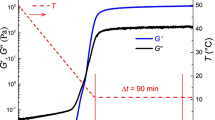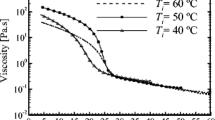Abstract
The yielding behavior of waxy crude oils below the gelation temperature is a fundamental aspect for the production in oil basins located in deep water. Under this state, the material exhibits a diversity of complex non-Newtonian features turning the determination of its rheology a challenging task. We performed different tests monitoring the critical stress and strain where a major rupture occurs. We could infer from these experiments a minimum critical stress value that can be associated to the static yield stress of the material. In addition, the material exhibited a remarkably constant critical strain value, turning this last parameter into a more representative fingerprint of the material.
























Similar content being viewed by others
References
Astarita G (1990) The engineering reality of the yield stress. J Rheol 34 (2):275–277
Balmforth NJ, Frigaard I, Ovarlez G (2014) Yielding to stress: Recent developments in viscoplastic fluid mechanics. Ann Rev Fluid Mech 46:45–64
Barnes HA (1999) The yield stress—a review. J Non-Newt Fluid Mech 81:133–178
Barnes HA, Walters K (1985) The yield stress myth?. Rheol Acta 24:323–326
Chang C, Nguyen QD, Bogger DV (1998) The yielding of waxy crude oils. Ind Eng Chem Res 37:1551–1559
Coussot P (2014) Yield stress fluid flows: a review of experimental data. J Non-Newt Fluid Mech 211:31–49
Coussot P, Nguyen QD, Huynh HT, Bonn D (2002) Viscosity bifurcation in thixotropic, yielding fluids. J Rheol 46:573–589
de Souza Mendes PR, Thompson RL (2013) A unified approach to model elasto-viscoplastic thixotropic yield-stress materials and apparent yield-stress fluids. Rheol Acta 58:1630–1640
de Souza Mendes PR, Thompson RL (2012) A critical o verview of elasto-viscoplastic thixotropic modeling. J Non-Newt Fluid Mech 187–188:8–15
Dimitriou CJ, McKinley GH (2014) A comprehensive constitutive law for waxy crude oil: a thixotropic yield stress fluid. Soft Matter 10 (35):6619–6644
Dimitriou CJ, McKinley GH, Venkatesan R (2011) Rheo-PIV analysis of the yielding and flow of model waxy crude oils. Energy & Fuels 25:3040–3052
Evans ID (1992) On the nature of the yield stress. J Rheol 36 (7):1313–1316
Fall A, Paredes J, Bonn D (2010) Yielding and shear banding in soft glassy materials. Phys Rev Letters 105:225502–1–225502–4
Hou L (2012) Experimental study on yield behavior of Daqing crude oil. Rheol Acta 51:603–607
Letoffe JM, Claudy P, Kok MV, Garcin M, Volle JL (1995) Crude oils: characterization of waxes precipitated on cooling by DSC and thermomicroscopy. Fuel 74 (6):810–817
Marchesini FH, Alexandra AA, de Souza Mendes PR, Ziglio CM (2012) Rheological characterization of waxy crude oils: Sample preparation. Energy & Fuels 26:1038–1048
Moller P, Fall A, Chikkadi V, Derks D, Bonn D (2009) An attempt to categorize yield stress fluid behavior. Phil Trans Royal Soc 367:5139–5155
Møller PCF, Mewis J, Bonn D (2006) Yield stress and thixotropy: on the difficulty of measuring yield stresses in practice. Soft Matter 2:274–283
Mujumdar A, Beris AN, Metzner AB (2002) Transient phenomena in thixotropic systems. J Non-Newtonian Fluid Mech 102:157–178
Olmsted PD (2008) Perspectives on shear banding in complex fluids. Rheol Acta 47:283–300
Schurz J (1990) The yield stress—an empirical reality. Rheol Acta 29:170–171
Soares EJ, Thompson RL, Machado A (2013) Measuring the yielding of waxy crude oils considering its time-dependency and apparent-yield-stress nature. Appl Rheol 23:62798–1–62798–11
Visitin RFG, Lapasin R, Vignati E, D’Antona P, Lockhart TP (2005) Rheological behavior and structural interpretation of waxy crude oil gels. Langmuir 21:6240–6249
Wardhaugh LT, Boger DV (1991) The measurement and description of the yielding behavior of waxy crude oil. J Rheol 35:8123–8133
Acknowledgments
This research was partially funded by grants from CNPq (Conselho Nacional de Pesquisa e Desenvolvimento), CAPES (Coordenação de Aperfeiçoamento de Pessoal de Nível Superior), ANP (Agência Nacional de Petróleo) and PETROBRAS.
Author information
Authors and Affiliations
Corresponding author
Rights and permissions
About this article
Cite this article
Tarcha, B.A., P. Forte, B.P., Soares, E.J. et al. Critical quantities on the yielding process of waxy crude oils. Rheol Acta 54, 479–499 (2015). https://doi.org/10.1007/s00397-015-0835-1
Received:
Revised:
Accepted:
Published:
Issue Date:
DOI: https://doi.org/10.1007/s00397-015-0835-1




